新概念英语第三册第3课课件
新概念英语第三册第3课课件

On the Aegean island of Aea
2.How do we know the city must have been prosperous?
Because it enjoyed a high level of civilization
Lesson3
An unknown goddess
Today we’ll learn a story about an archaeological discovery in Greece.In the story the archaeologists found clay fragments in an ancient temple.These represented the fifteenth statues of goddess which had once been painted .The body of one statue was found among remains from the fifteenth century B.C.Which it’s head was found among remains from the fifth century B.C.
The body of one statue was found among remains dating from the fifteenth centuryB.C
Its missing head happened to be among remains of the fifth century B.C
(10).worship n. 崇拜
a place of worship 祭祀祷告的场所
Lesson3新概念第三册第三课ppt课件

-- classical music
古典音乐
classical education 人文科学教育
• Classic adj. 第一流的, 标准的, 著名的, 典型的
• -- This is the classic example of love at the first sight.
• - That joke's a classic; it really is funny.
e.g He is under/ beneathe the umbrella. under control/discussion (进行中)
• 6.The temple which the archaeologists explored was used as a place of worship from the fifteenth century B.C. until Roman times.
• 【词义辨析】civilization, culture这两个词均含“文化,文明”
之意。
civilization: 指广义的文化,标志人类发展开化的进程。强调物 质方面的文明。
culture: 侧重指精神方面,即多由科技、文化等所体现的人类智 力开发的程度。
➢ storey [‘stɔ:ri] n. 楼层 =story(美) ➢ drainage [‘dreinidʒ] v. 排水 n. 排水系统,污水
• Reconstruct [.ri:kən‘strʌkt] vt. 重建,修复,重现 ➢ Construct [kən‘strʌkt] vt. 构筑,建造 n. 构想 construction n.建设, 建造 constructive adj.有教育意义的
新概念三第3课课件(课堂PPT)

Blessed adj. 神圣的,快乐的 the Blessed Virgin (the Virgin Mary)圣母玛利亚
12
Fragment
n. 碎片 fall/break into fragments/pieces摔成碎片
20
16
rest
v. 倚放,放置 eg. He rested his bicycle against the wall. rest sth. on/against sth. 依赖于,依靠于 eg. We rest our hopes on you. rest on/upon 依靠;寄托在 eg. The plan rests on your cooperation.
gracious adj. 和蔼可亲的;彬彬有礼的;不端架子的
Eg. 1. She was gracious enough to show us round her home. 2. He has a gracious smile. 3. She was the most gracious hostess I’ve ever known.
drain v. 排水,流干;n. 排水;下水道,排水系统 brain drain 人才流失 go down the drain 白白浪费掉,付之东流
eg. First you must drain the dirty water out and then clean the pipe.
drain A of B 排去A中的B Overwork has drained him of al his energy.过度的工作已经耗尽了他所有的精力。
新概念英语第三册Lesson3课件_PPT

10. Sacred adj. 神圣的,宗教的
a sacred place 圣地 a sacred oath[əʊθ] 神圣的誓言 sacred music 宗教音乐;sacred history 宗教史
Holy adj. 神圣的 the holy city: Jerusalem [dʒə'ru:sələm] 耶路撒冷 Holy shit 天啊!见鬼! Silent night, holy night, all is calm, all is bright. 平安夜,圣善夜,万暗中,光华射
civil servant 公仆
civil law 民法 civil war 内战
domestic adj. [dəˈmestɪk] 家庭的,国内的,驯养的 domestic market 国内市场 domestic violence 家庭暴力 domestic flights 国内航班
8. Storey n. 楼层(Am.E.: story)
be really hip 非常时尚 ass 屁股 buttock [ˈbʌtək] 臀部
full-length adj. (裙衣)拖地长的,全长的 A full-length skirt The boy lay at full length on the grass. 男孩伸直身体躺在草地上。 He fell full length. 他直挺挺地跌倒在地上。
e.g. If you reconstruct something that has been destroyed or badly damaged, you build it and make it work again.
The government must reconstruct the shattered(破碎的) economy. 政府必须重建支离破碎的经济。
新概念英语NCE3_lesson03(共27页)课件
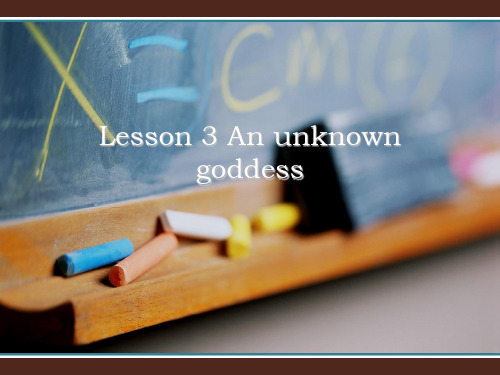
fragment n.碎片 fall into fragment/piece fraction 一小份 segment 一块、一
瓣
make a discovery 做出发现 make a name for oneself make history make a noise Ben Laden really made a noise by
• pirate :海盗 • prosperous: adj.繁荣昌盛的 • prosperity. n • We will keep the prosperity and stability of HK at any
cost. • slump n.衰退 • slump in stock • slack a.松弛的,不振作的,经济衰退的 • in low time
election. • enjoy good health • enjoy large sales • enjoy a handsome income
音乐和艺术
• be built of stone • be made of stone • He is made of stone • with作为抽象含义而使用,指事物的性质和特征。这种表
Lesson 3 An unknown goddess
爱琴海文明
• 爱琴文明是指公元前20世纪至公元前12世纪间的爱琴海域 的上古文明。它是指公元前20年~前12世纪存在于地中海 东部的爱琴海岛、希腊半岛及小亚细亚西部的欧洲青铜时 代的文明,因围绕爱琴海域而得名。在希腊文明之前,是 最早的欧洲文明,是西方文明的源泉。
About Greece
The famous god and goddess
• 古希腊人信奉的诸神,主要包 括有主神宙斯(Zeus)、天后赫拉 (Hera)、海神波塞冬(Poseidon )、智慧女神雅典娜(Athena )、 美神维纳斯(Venus)、太阳神阿 波罗(Apollo)、月亮与狩猎女神 阿尔泰弥斯、谷物女神德墨忒 尔 、火神赫菲斯托斯、战神阿 瑞斯、众神使者与亡灵接引神 赫尔墨斯、灶神或家室女神赫 斯提,有时也包括酒神狄俄尼 索斯和英雄赫拉克勒斯。
新概念英语第三册PPT课件:NCE3_lesson03(共41页)

• Interviewer interviewee
• Fragment 碎片 • Frag-, fract 破裂 • Fragile [‘fræ dʒail] • fraction [‘fræ kʃən]部分 • fractional [‘fræ kʃənəl]很少的 • Fracture['fræ ktʃə]破裂、骨折
、效果为主语,强调对客观事实的陈述。
An American team explored a temple (which stands in an ancient city on the promontory of Ayia Irini.)
stand (vi.==)lsiietua(tvei.[)'s位it于jueit] (vt.)使位于,
• Do you know the statue? • Is she a modern-looking woman? • Is she a goddess? • Do you worship the goddess? • What is she wearing? • Can you make sure her identity?
civilize (v)使某人开化 civilized (adj) 文明的 有礼貌 的
worship <n./v.> 祟拜 ,敬仰
respect vt.尊敬, 尊重 admire v.赞美, 钦佩, 羡慕 Who do you worship in the world? a blind worship 盲目的崇拜
第1 章
ቤተ መጻሕፍቲ ባይዱText
Aegean
• Some time ago, an interesting discoverywa s made by archaeologists on the
新概念英语第三册Lesson3
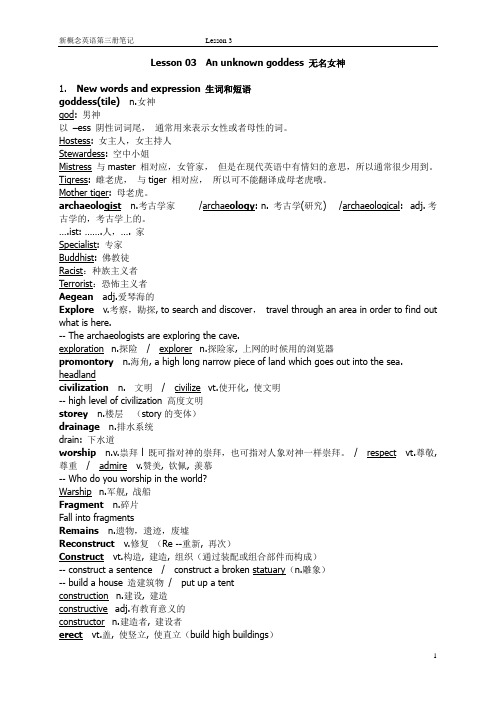
Lesson 03 An unknown goddess 无名女神1.New words and expression 生词和短语goddess(tile) n.女神god: 男神以–ess 阴性词词尾,通常用来表示女性或者母性的词。
Hostess: 女主人,女主持人Stewardess: 空中小姐Mistress 与master 相对应,女管家,但是在现代英语中有情妇的意思,所以通常很少用到。
Tigress: 雌老虎,与tiger 相对应,所以可不能翻译成母老虎哦。
Mother tiger: 母老虎。
archaeologist n.考古学家/archae ology: n. 考古学(研究) /archaeological: adj.考古学的,考古学上的。
….ist: …….人,…. 家Specialist: 专家Buddhist: 佛教徒Racist:种族主义者Terrorist:恐怖主义者Aegean adj.爱琴海的Explore v.考察,勘探, to search and discover,travel through an area in order to find out what is here.-- The archaeologists are exploring the cave.exploration n.探险/ explorer n.探险家, 上网的时候用的浏览器promontory n.海角, a high long narrow piece of land which goes out into the sea. headlandcivilization n. 文明/ civilize vt.使开化, 使文明-- high level of civilization 高度文明storey n.楼层(story的变体)drainage n.排水系统drain: 下水道worship n.v.祟拜l 既可指对神的崇拜,也可指对人象对神一样崇拜。
新概念第三册第三课之欧阳美创编

Lesson 3 An unknowngoddess 无名女神Listen to the tape then answer the question below.听录音,然后回答以下问题。
How did the archaeologists know that the statue was a goddess?Some time ago, an interesting discovery was made by archaeologists on the Aegean island of Kea. An American team explored a temple which stands in an ancient city on the promontory of Ayia Irini. The city at one time must have been prosperous, for it enjoyed a high level of civilization. Houses----often three storeys high----were built of stone. They had large rooms with beautifully decorated walls. The city was even equipped with a drainage system, for a great many clay pipes were found beneath the narrow streets.The temple which the archaeologists explored wasused as a place of worship from the fifteenth century B.C. until Roman times. In the most sacred room of the temple, clay fragments of fifteen statues were found. Each of these represented a goddess and had, at one time, been painted. The body of one statue was found among remains dating from the fifteenth century B. C.Its missing head happened to be among remains of thefifth century B. C. This head must have been found in Classical times and carefully preserved. It was veryold and precious even then. When the archaeologists reconstructed the fragments, they were amazed to find that the goddess turned out to be a very modern-looking woman. She stood three feet high and her hands restedon her hips. She was wearing a full-length skirt which swept the ground. Despite her great age, she was very graceful indeed, but, so far, the archaeologists have been unable to discover her identity.New words and expressions生词和短语goddess(title) /'g&dis/ n.女神sacred(1. 10)/'seikrid/ adj.宗教的,神圣的archaeologist(1. 1) /?a:ki'&ld{ist/ n.考古学家fragment(1. 10) /'fr$gm+nt/n.碎片Aegean(1. 2) /i:'d{i:+n/ adj.爱琴海的remains(1. 12)/ri'menz/ n.遗物,遗迹,废墟explore(1. 2) /ik'spl&:/ v.考察,勘探classical(1. 13)/'kl$sik+l/ adj.(希腊和罗马)古文化的promontory(1. 3) /'pr&m+nt+ri/ n.海角prosperous(1. 4) /'pr&sp+r+s/ adj.(经济上)繁荣reconstruct(1. 14) /?r(ikn'strkt/ v.修复的,昌盛的rest(1. 16)/rest/ v.倚放,放置civilization(1. 5) /?siv+l-ai'zeiM+n/ n.文明hip(1. 16) /hip/ n.屁股,臀部storey(1. 5) /'st&:ri/ n.楼层full-length(1. 16) /?ful'leRI/adj.(裙衣)拖地长的drainage(1. 7)/'dreinid{/ n.排水graceful(1. 17) /'greisf+l/ adj.优雅的worship(1. 9) /'w*:Mip/ n.祟拜identity(1. 17) /ai'dentiti/ n.身份Notes on the text课文注释1 the Aegean island of Kea, 爱琴海的基亚岛。
新概念英语第三册1--3课课件

Lesson one 课后习题
• • • • • • • • • 1. D A 只是一个具体的特定的事例,阅读理 解题的时候要把握中心大意 B large cat 关键性用词 2. B 3. C 4.make----make sb. do, be made to do 主动语态中不定式to的符号应该省略 被 动语态中不定式to的符号必须补充完整 5D 把say改成claim---People claimed to have seen the puma. 6.B 与原句中的when意思要一致,when引 导的时间状语从句表示一 结构形式和as soon as 相一致的 如果用主动: On observing her, it immediately ran away. On seeing me, he waved to me. • • • • 7. D 原句中unles----if…not / except on the condition thatwhen=if except可以和名词/名词性从句进行搭配, 也可以是when / if 引导的从句形式。 8. D must be 只是对客观现实的推测, 时态不一致 情态动词表达推测的语意 概念时,对于过去事实推测一定要用于 情态动词have以及过去分词形式进行搭 配。 9 C no more than = only within = not more than 10 B .in a corner 表示处于困境、尴尬 的境地 in a trap 表示落于陷阱中 at an angle 表示弯曲的、不直的 11 fishes for pleasure 钓鱼为了游玩 12、 A .on his own = alone C选项是秘密的, D选项是不为总人所知的。不符合语义。
• • •
新概念第三册lesson3课件共54张PPT)
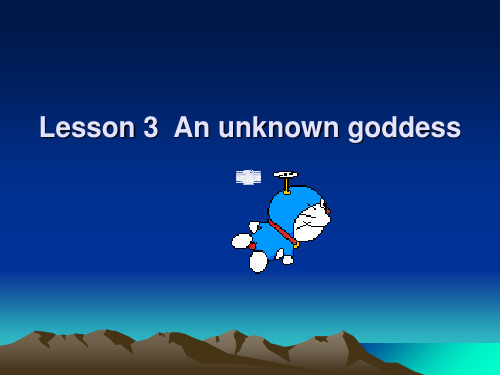
• dentist • journalist • receptionist • typist • tourist • buddhist • socialist • communist
• marxist • terrorist • sociologist
t 博物学家,自然主义者
• Warship :军舰,战舰 • Worship: 祭祀,崇拜,敬慕 admire,respect • Who do you worship in the world?
• Pray : ask God for help • hero worship / worship of the money
island.
• promontory: a high narrow piece of land that goes out into the sea
• The Cape of good hope • Taiwan strait • English Channel
• promontory • The Cape of good hope
Lesson 3 An unknown goddess
读 《 悲 惨 世 界》有 感1000字 雨 果 说 有 一 种比天 空更大 的景象 ,那便是 人心。 下面是 XX为大 家整理 的仅供 参考,
更 多 内 容 请 继续关 注XXXX 【 一 】 上 帝 欲 叫 人 灭亡,先 叫人疯 狂。这 是出自 卡夫卡 的一句 话,我觉 得现实 就是这 样,正 如 悲 惨 世 界 中的冉 阿让,偷 了一块 面包给 外甥,竟 然被判 了十九 年的刑 ,现实 把我们
• prosperous adj. (经济上)繁荣的,昌盛 的
• Our finance is prosperous. 我们的经济非 常的繁荣。(Finance n.财政, 金融)
新概念三第三课

笑话确属一流,真是妙趣横生。"
Reconstruct v.修复 (Re --重新, 再次) Construct vt.构造, 建造, 组织 (通过装配或组合部件而构成)
stand(不及物) = lie(不及物) 位于 = situate(及物) 使位于, 使处于 = locate(及物) 使...坐落于, 位于
which stands in... = which lies in… = which is located in… = which is situated in...
Stand 1 >身高 2>表示高高坐落于, 矗立于 -- She stands 1.75m. 她身高1.75米 -- A great tree stands on the mount. 一棵大树竖立在山上。
The city at one time must have been prosperous, for it enjoyed a high level of civilization.
Classical adj.(希腊和罗马)古文化的(即传 统的);文科的, 人文科学的 -- classical music 古典音乐 classical education 人文科学教育
Classic adj.第一流的, 标准的, 著名的, 典型的 -- This is the classic example of love at the first sight.
Warship n.军舰, 战船
Sacred adj.宗教的, 神圣的 -- sacred music 圣乐 sacred promise神圣的诺言 Holy adj.神圣的, 圣洁的 -- a holy person. 圣洁的人 a holy place. 神圣的地方
新概念第三册lesson3课件共54张PPT)
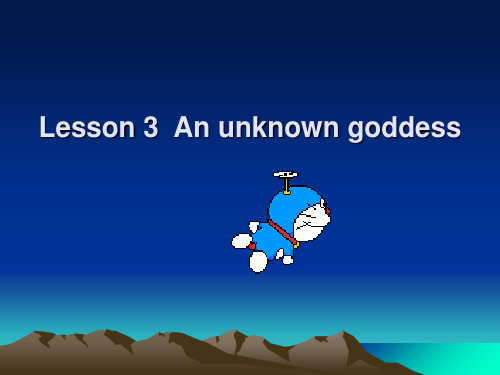
• prosperous adj. (经济上)繁荣的,昌盛 的
• Our finance is prosperous. 我们的经济非 常的繁荣。(Finance n.财政, 金融)
• thriving adj.昌盛的,兴旺的
• -- tadj.蓬勃的,景气的
的地方
• Blessed: adj. 有福的; 神圣的; 无忧无虑的;
• The Blessed Virgin: the Virgin Mary, mother of Christ
• Solemn [ˈsɒləm] adj. 庄严的, 庄重的 • -- a solemn face 严肃的面孔 / • -- a solemn ceremony 隆重的仪式
生物学 技术 生态学 地质学 心理学 社会学
• Arch:[ɑ:tʃ]拱形,拱门 • Archaic: [ɑ:ˈkeɪɪk]古代的,古老的 • Archetype:[ˈɑ:kitaɪp]典型,原型
explore
• They spent many years ______for oil in this small island.
• A. exploring B. exploding • C. exposing D. exploiting • Explore v.考察,勘探 • The archaeologists are exploring the cave. • exploration n.探险 / explorer n.探险家 • 专家们正在勘探这个岛的各个部分。 • The experts are exploring every part of the
Lesson 3 An unknown goddess
• goddess n.女神 • sacred adj.宗教的,神圣的 • archaeologist n.考古学家 • fragment n.碎片 • Aegean adj.爱琴海的
新概念英语第三册第3课An unknown goddess

新概念英语第三册第3课:An unknown goddessLesson 3 An unknown goddess 无名女神听录音,然后回答以下问题。
How did the archaeologists know that the statue was a goddess?Some time ago, an interesting discovery was made by archaeologists on the Aegean island of Kea. An American team explored a temple which stands in an ancient city on the promontory of Ayia Irini. The city at one time must have been prosperous, for it enjoyed a high level of civilization. Houses -- often three storeys high -- were built of stone. They had large rooms with beautifully decorated walls.The city was equipped with a drainage system, for a great many clay pipes were found beneath the narrow streets.The temple which the archaeologists explored was used as a place of worshipfrom the fifteenth century B.C. until Roman times. In the most sacred room of temple, clay fragments of fifteen statues were found. Each of these represented a goddess and had, at one time, been painted. The body of one statue was found among remains dating from the fifteenth century B.C. It's missing head happened to be among remains of the fifth century B.C. This head must have been found in Classical times and carefully preserved. It was very old and precious even then. When the archaeologists reconstructed the fragments, they were amazed to find that the goddess turned out to be a very modern-looking woman. She stood three feet high and her hands rested on her hips. She was wearing a full-length skirt which sweptthe ground. Despite her great age, she was very graceful indeed, but, so far, the archaeologists have been unable to discover her identity.参考译文不久之前,在爱琴海的基亚岛上,考古工作者有一项有趣的发现。
新概念第三册第三课之欧阳法创编

Lesson 3 An unknowngoddess 无名女神Listen to the tape then answer the question below.听录音,然后回答以下问题。
How did the archaeologists know that the statue was a goddess?Some time ago, an interesting discovery was made by archaeologists on the Aegean island of Kea. An American team explored a temple which stands in an ancient city on the promontory of Ayia Irini. The city at one time must have been prosperous, for it enjoyed a high level of civilization. Houses----often three storeys high----were built of stone. They had large rooms with beautifully decorated walls. The city was even equipped with adrainage system, for a great many clay pipes were found beneath the narrow streets.The temple which the archaeologists explored was used as a place of worship from the fifteenth century B. C. until Roman times. In the most sacred room of the temple, clay fragments of fifteen statues were found. Each of these represented a goddess and had, at one time, been painted. The body of one statue was found among remains dating from the fifteenth century B. C. Its missing head happened to be among remains of the fifth century B. C. This head must have been found in Classical times and carefully preserved. It was very old and precious even then. When the archaeologists reconstructed the fragments, they were amazed to find that the goddess turned out to be a very modern-looking woman. She stood three feet high and her hands rested on her hips. She was wearing a full-length skirt which swept the ground. Despite her great age, she was very graceful indeed, but, so far, the archaeologists have been unable to discover her identity.New words and expressions生词和短语goddess(title) /'g&dis/ n.女神sacred(1. 10)/'seikrid/ adj.宗教的,神圣的archaeologist(1. 1) /?a:ki'&ld{ist/ n.考古学家fragment(1. 10) /'fr$gm+nt/n.碎片Aegean(1. 2) /i:'d{i:+n/ adj.爱琴海的remains(1. 12)/ri'menz/ n.遗物,遗迹,废墟explore(1. 2) /ik'spl&:/ v.考察,勘探classical(1. 13)/'kl$sik+l/ adj.(希腊和罗马)古文化的promontory(1. 3) /'pr&m+nt+ri/ n.海角prosperous(1. 4) /'pr&sp+r+s/ adj.(经济上)繁荣reconstruct(1. 14) /?r(ikn'strkt/ v.修复的,昌盛的rest(1. 16)/rest/ v.倚放,放置civilization(1. 5) /?siv+l-ai'zeiM+n/ n.文明hip(1. 16) /hip/ n.屁股,臀部storey(1. 5) /'st&:ri/ n.楼层full-length(1. 16) /?ful'leRI/adj.(裙衣)拖地长的drainage(1. 7)/'dreinid{/ n.排水graceful(1. 17) /'greisf+l/ adj.优雅的worship(1. 9) /'w*:Mip/ n.祟拜identity(1. 17) /ai'dentiti/ n.身份Notes on the text课文注释1 the Aegean island of Kea, 爱琴海的基亚岛。
(完整版)新概念英语第三册课文及详解第3课
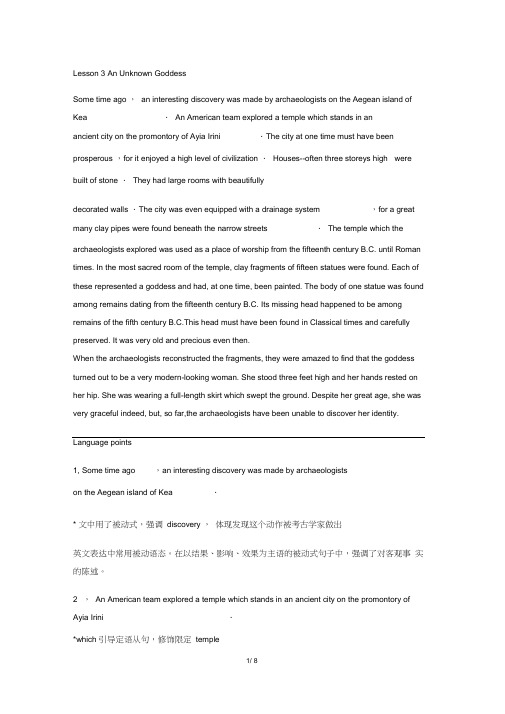
Lesson 3 An Unknown GoddessSome time ago ,an interesting discovery was made by archaeologists on the Aegean island of Kea .An American team explored a temple which stands in anancient city on the promontory of Ayia Irini .The city at one time must have been prosperous ,for it enjoyed a high level of civilization .Houses--often three storeys high were built of stone .They had large rooms with beautifullydecorated walls .The city was even equipped with a drainage system ,for a great many clay pipes were found beneath the narrow streets .The temple which the archaeologists explored was used as a place of worship from the fifteenth century B.C. until Roman times. In the most sacred room of the temple, clay fragments of fifteen statues were found. Each of these represented a goddess and had, at one time, been painted. The body of one statue was found among remains dating from the fifteenth century B.C. Its missing head happened to be among remains of the fifth century B.C.This head must have been found in Classical times and carefully preserved. It was very old and precious even then.When the archaeologists reconstructed the fragments, they were amazed to find that the goddess turned out to be a very modern-looking woman. She stood three feet high and her hands rested on her hip. She was wearing a full-length skirt which swept the ground. Despite her great age, she was very graceful indeed, but, so far,the archaeologists have been unable to discover her identity.Language points1, Some time ago ,an interesting discovery was made by archaeologistson the Aegean island of Kea .* 文中用了被动式,强调discovery ,体现发现这个动作被考古学家做出英文表达中常用被动语态。
(完整版)新概念英语第三册课文及详解第3课
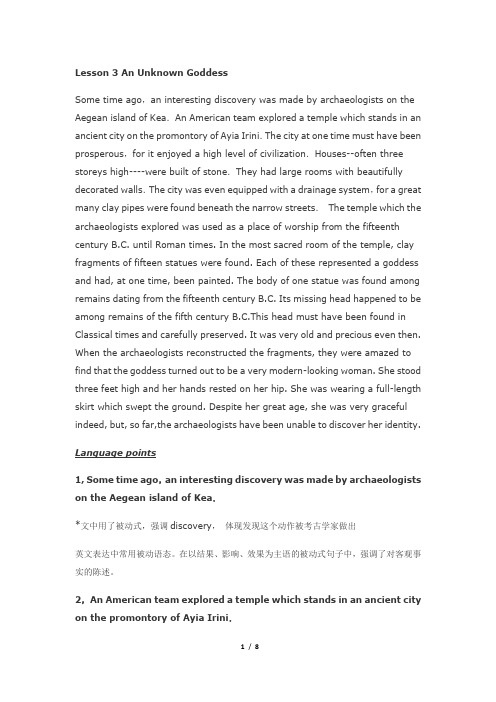
Lesson 3 An Unknown GoddessSome time ago,an interesting discovery was made by archaeologists on the Aegean island of Kea.An American team explored a temple which stands in an ancient city on the promontory of Ayia Irini.The city at one time must have been prosperous,for it enjoyed a high level of civilization.Houses--often three storeys high----were built of stone.They had large rooms with beautifully decorated walls.The city was even equipped with a drainage system,for a great many clay pipes were found beneath the narrow streets.The temple which the archaeologists explored was used as a place of worship from the fifteenth century B.C. until Roman times. In the most sacred room of the temple, clay fragments of fifteen statues were found. Each of these represented a goddess and had, at one time, been painted. The body of one statue was found among remains dating from the fifteenth century B.C. Its missing head happened to be among remains of the fifth century B.C.This head must have been found in Classical times and carefully preserved. It was very old and precious even then. When the archaeologists reconstructed the fragments, they were amazed to find that the goddess turned out to be a very modern-looking woman. She stood three feet high and her hands rested on her hip. She was wearing a full-length skirt which swept the ground. Despite her great age, she was very graceful indeed, but, so far,the archaeologists have been unable to discover her identity.Language points1, Some time ago,an interesting discovery was made by archaeologists on the Aegean island of Kea.*文中用了被动式,强调discovery,体现发现这个动作被考古学家做出英文表达中常用被动语态。
新概念第3册第3课ppt

storey n.楼层 drainage n.排水 Draining system=drainage system Drain =ditch 下水道
worship n.v.祟拜 / respect vt.尊敬, 尊 重 / admire v.赞美, 钦佩, 羡慕 adore
-- Who do you worship in the world? Warship n.军舰, 战船 The worship of money His admirers worshipped at his feet. Worship is in Sunday at 11 am.
promontory n.English Channel Strait Taiwan strait
prosperous adj. (经济上)繁荣的, 昌盛的
-- our finance is prosperous 我们的经济非常 的繁荣。 thriving adj.昌盛的,兴旺的 -- thriving business booming adj.蓬勃的,景气的 -- a booming market繁荣的市场 flourishing adj.繁茂的,健康的 -- Those plants are flourishing. 那些植物长得 茂盛。
Fragment n.碎片 Fraction Remains n.遗物,遗迹,废墟 The remains of the meal is in the refrigerator. The remains of ancient Rome His remains were buried in the churchyard. Be in ruins remainder
新概念第三册第三课之欧阳数创编
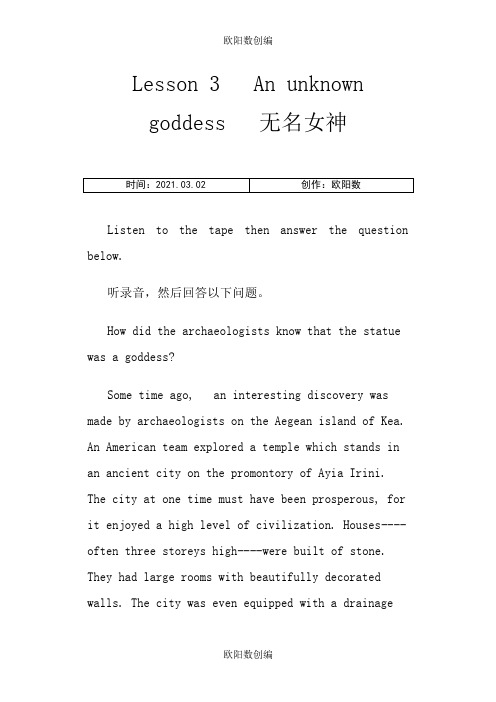
Lesson 3 An unknowngoddess 无名女神Listen to the tape then answer the question below.听录音,然后回答以下问题。
How did the archaeologists know that the statue was a goddess?Some time ago, an interesting discovery was made by archaeologists on the Aegean island of Kea. An American team explored a temple which stands in an ancient city on the promontory of Ayia Irini. The city at one time must have been prosperous, for it enjoyed a high level of civilization. Houses----often three storeys high----were built of stone. They had large rooms with beautifully decorated walls. The city was even equipped with a drainagesystem, for a great many clay pipes were found beneath the narrow streets.The temple which the archaeologists explored was used as a place of worship from the fifteenth century B. C. until Roman times. In the most sacred room of the temple, clay fragments of fifteenstatues were found. Each of these represented a goddess and had, at one time, been painted. Thebody of one statue was found among remains dating from the fifteenth century B. C. Its missing head happened to be among remains of the fifth century B.C. This head must have been found in Classicaltimes and carefully preserved. It was very old and precious even then. When the archaeologists reconstructed the fragments, they were amazed tofind that the goddess turned out to be a very modern-looking woman. She stood three feet high and her hands rested on her hips. She was wearing afull-length skirt which swept the ground. Despite her great age, she was very graceful indeed, but,so far, the archaeologists have been unable to discover her identity.New words and expressions生词和短语goddess(title) /'g&dis/ n.女神sacred(1. 10)/'seikrid/ adj.宗教的,神圣的archaeologist(1. 1) /?a:ki'&ld{ist/ n.考古学家fragment(1. 10) /'fr$gm+nt/n.碎片Aegean(1. 2) /i:'d{i:+n/ adj.爱琴海的remains(1. 12)/ri'menz/ n.遗物,遗迹,废墟explore(1. 2) /ik'spl&:/ v.考察,勘探classical(1. 13)/'kl$sik+l/ adj.(希腊和罗马)古文化的promontory(1. 3) /'pr&m+nt+ri/ n.海角prosperous(1. 4) /'pr&sp+r+s/ adj.(经济上)繁荣reconstruct(1. 14) /?r(ikn'strkt/ v.修复的,昌盛的rest(1. 16)/rest/ v.倚放,放置civilization(1. 5) /?siv+l-ai'zeiM+n/ n.文明hip(1. 16) /hip/ n.屁股,臀部storey(1. 5) /'st&:ri/ n.楼层full-length(1. 16) /?ful'leRI/adj.(裙衣)拖地长的drainage(1. 7)/'dreinid{/ n.排水graceful(1. 17) /'greisf+l/ adj.优雅的worship(1. 9) /'w*:Mip/ n.祟拜identity(1. 17) /ai'dentiti/ n.身份Notes on the text课文注释1 the Aegean island of Kea, 爱琴海的基亚岛。
新概念第三册第三课之欧阳学创编
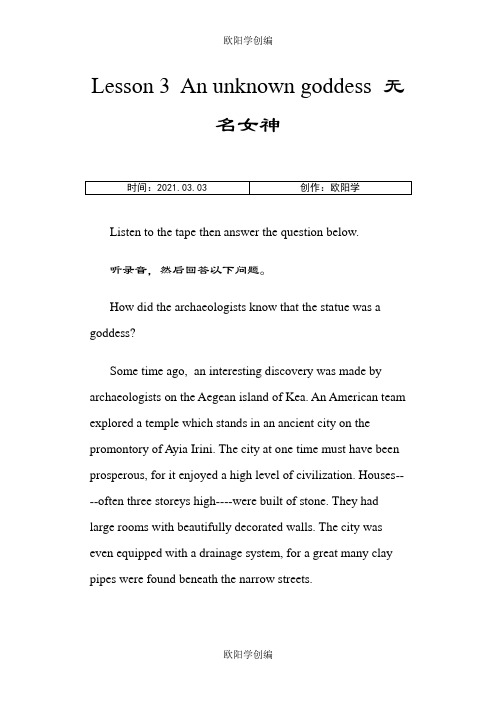
Lesson 3 An unknown goddess 无名女神Listen to the tape then answer the question below.听录音,然后回答以下问题。
How did the archaeologists know that the statue was a goddess?Some time ago, an interesting discovery was made by archaeologists on the Aegean island of Kea. An American team explored a temple which stands in an ancient city on the promontory of Ayia Irini. The city at one time must have been prosperous, for it enjoyed a high level of civilization. Houses----often three storeys high----were built of stone. They had large rooms with beautifully decorated walls. The city was even equipped with a drainage system, for a great many clay pipes were found beneath the narrow streets.The temple which the archaeologists explored was used as a place of worship from the fifteenth century B. C. until Roman times. In the most sacred room of the temple, clay fragments of fifteen statues were found. Each of these represented a goddess and had, at one time, been painted. The body of one statue was found among remains dating from the fifteenth century B. C. Its missing head happened to be among remains of the fifth century B. C. This head must have been found in Classical times and carefully preserved. It was very old and precious even then. When the archaeologists reconstructed the fragments, they were amazed to find that the goddess turned out to be a very modern-looking woman. She stood three feet high and her hands rested on her hips. She was wearing a full-length skirt which swept the ground. Despite her great age, she was very graceful indeed, but, so far, the archaeologists have been unable to discover her identity.New words and expressions生词和短语goddess(title) /'g&dis/ n.女神sacred(1. 10)/'seikrid/ adj.宗教的,神圣的archaeologist(1. 1) /?a:ki'&ld{ist/ n.考古学家fragment(1. 10) /'fr$gm+nt/n.碎片Aegean(1. 2) /i:'d{i:+n/ adj.爱琴海的remains(1. 12)/ri'menz/ n.遗物,遗迹,废墟explore(1. 2) /ik'spl&:/ v.考察,勘探classical(1. 13)/'kl$sik+l/ adj.(希腊和罗马)古文化的promontory(1. 3) /'pr&m+nt+ri/ n.海角prosperous(1. 4) /'pr&sp+r+s/ adj.(经济上)繁荣reconstruct(1. 14) /?r(ikn'strkt/ v.修复的,昌盛的rest(1. 16)/rest/ v.倚放,放置civilization(1. 5) /?siv+l-ai'zeiM+n/ n.文明hip(1. 16) /hip/ n.屁股,臀部storey(1. 5) /'st&:ri/ n.楼层full-length(1. 16) /?ful'leRI/adj.(裙衣)拖地长的drainage(1. 7)/'dreinid{/ n.排水graceful(1. 17) /'greisf+l/ adj.优雅的worship(1. 9) /'w*:Mip/ n.祟拜identity(1. 17) /ai'dentiti/ n.身份Notes on the text课文注释1 the Aegean island of Kea, 爱琴海的基亚岛。
- 1、下载文档前请自行甄别文档内容的完整性,平台不提供额外的编辑、内容补充、找答案等附加服务。
- 2、"仅部分预览"的文档,不可在线预览部分如存在完整性等问题,可反馈申请退款(可完整预览的文档不适用该条件!)。
- 3、如文档侵犯您的权益,请联系客服反馈,我们会尽快为您处理(人工客服工作时间:9:00-18:30)。
9.What hid the archaeologists do to the fragments?
They reconstructed then
(6).否定词用句首时 要倒装
1.否定词或具有否定含义的副词, 如:never .rarely .seldom.little . on no account 等用于句首时,必 须后接(be,do ,have,can,must,+ 主语+句子的其他部分)
Which it’s head was found among remains from the fifth century B.C.When the fragments mere reconstructed,they turned out to be a goddess which stood three feet high .Her hands rested on hips and she was wearing a full_length skirt .Her identity is unknown.
(13).remains
n. 遗物,遗迹,废墟
the remains of meal
the remains of ancient Rome
(14).classical
adj. (希腊和罗马)古文 化的
classical studies 古代文学 研究/古典研究 classical music 古典音乐
In the most sacred room of the temple ,clay fragments of fifteen statue were found
Each of these represented a goddess and had ,at one time ,been painted
Now learn the new words. (1).goddess. n. 女神 (2).archaeologist n.考古学家
archa =ancient ology =to study
-ist =....(人)
biology 生物学 biologist 生物学家 geology 地质学 geologist地质学家
The city an one time mast have been prosperous,for it enjoyed a high level of civilization
House_often three storeys high_were built of stone .They had large rooms with beautifully decorated walls.
阁楼
顶层
.....
二层 一层
地下室
英式 美式
attic
The top floor
.....
.....
The first floor The second floor
The ground floor The first floor
basement
(9).drainage n.排水
drainage system 排水系统
The city was even equipped with a drainage ,for a great many clay pipes were found beneath the narrow streets.
The temple which the archaeologists explored was used as a place of worship from the fifteenth century B.C.until Roman times
Lesson 3 An unknown
goddess
Some time ago ,an interesting discovery was made by archaeologists on the Aegean island of Kea
An American team explored a temple which stands in an ancient city on the promontory of Ayia Irini
She stood three feet high and her hands rested on her hips
She was wearing a full_length skirt which swept the ground
Despite her great age,she was very graceful indeed ,but,so far,the archaeologists have been unable to discover her identity.
3.How high were some of the houses?
Three storeys
4.what were they built of? Stone
5.what was the city equipped with? A drainage system
6.They found fragments of statues.How many statues? Fifteen
physiology 物理学 physiologist 物理学家
(3).Aegean adj.爱琴海的
(4).explore v. 考察,勘探
explorer.勘探家 exploration 探险 adventure 探险
venture 探险
(5).promontory
n.海南
promontory of Ayia Irini 阿依亚.依里尼海角
你是有几个问题要问吧?
Do you have any questions ?
你有问题要问吗?
discovery 一词常与动词 make搭配使用,后面常 与about/in/of连用
Eg: They made a new discovery in astronomy
他们在天文学上有了新发现
(1).in which引导一定 语从句,修饰a fax,此处in 不能省略,相当于in the
(15).reconstruct
v.修复,改造,宫廷。
build again reconstruct=rebuild
(16).rest V.倚放,放置 rest on/upon
Eg: Aer hands rested on her hips.
(17).hip n. 屁股,臀部
(18).full-length
adj.(裙衣)拖地长的。
A full-length skirt
(19).graceful
adj.优雅的
(20).identity n. 身份
identity card 身份证
After learning the new words.Now try to answer the question,and do the ask and answer.
Text.课文讲解
Some time ago ,an interesting discovery was made by archaeologists on the Aegean island of Kea.
•.some time “一段时 间”或“较长一段时 间”
Do you have smust have been found in Classical times and carefully preserved
It was very old and precious even then
When the archaeologists reconstructed the fragments ,the were amazed to find that the goddess turned out to be a very modern_looking woman
The body of one statue was found among remains dating from the fifteenth centuryB.C
Its missing head happened to be among remains of the fifth century B.C
7.What did these statues represent?
Goddess
8.What was interesting about the body and head of one of the statues?
The body was among remains dating from the fifteenth century and the head among the remains of the fifth century B.C
1.where was this interesting discovery made?
On the Aegean island of Aea
2.How do we know the city must have been prosperous?
Because it enjoyed a high level of civilization
Lesson3
An unknown goddess
Today we’ll learn a story about an archaeological discovery in Greece.In the story the archaeologists found clay fragments in an ancient temple.These represented the fifteenth statues of goddess which had once been painted .The body of one statue was found among remains from the fifteenth century B.C.Which it’s head was found among remains from the fifth century B.C.
